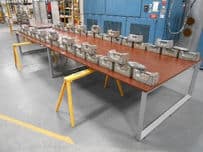Committee Ballot CAN/CGSB 44.227
CGSB has been reviewing its CAN/CGSB 44.227 standard through a working group for efficiency reasons. I was part of that working group. I really like this formula as this is much more efficient than the full meetings where a lot of time is wasted for “red tape” purposes. The standard is now up for committee ballot. Committee members have to submit their comments before September 30th. This standard still calls up BIFMA X5.5, BIFMA X 5.9 and some Coating testing as well as some dimensional criteria. You will find below our comments about this standard. We trust this will help you better understand where this standard is going and vote appropriately.
 In parallel to this work Public Works Canada (PWGSC) is still struggling to finalize its supply agreement bidding process for Panel Systems, Freestanding Furniture and Storage Cabinets. Per the current RFSA document re-testing must be done within a 9 month period once a standard has been issued. I do not foresee be many contentious issues with the current CAN/CGSB 44.227 standard re-write. Please bear in mind that once the standard comes out, you only have to prove you meet the requirements of the new standard. Which means if the new standard did not change significantly from the old one or if the requirements are easier to meet then you don’t have to re-test. That is unless your test reports are older than five years; which is another requirement from PWGSC.
In parallel to this work Public Works Canada (PWGSC) is still struggling to finalize its supply agreement bidding process for Panel Systems, Freestanding Furniture and Storage Cabinets. Per the current RFSA document re-testing must be done within a 9 month period once a standard has been issued. I do not foresee be many contentious issues with the current CAN/CGSB 44.227 standard re-write. Please bear in mind that once the standard comes out, you only have to prove you meet the requirements of the new standard. Which means if the new standard did not change significantly from the old one or if the requirements are easier to meet then you don’t have to re-test. That is unless your test reports are older than five years; which is another requirement from PWGSC.
For more information about this revised standard and our furniture testing services, please don’t hesitate to contact us.
Micom is a material testing industrial laboratory accredited by A2LA, CGSB and ISTA.
| Canadian General Standards Board
Office |
Comments and secretariat observationsCommentaires et note du secrétaire |
CAN/CGSB-44.227 Freestanding |
Date 2015 |
|||
|
1 |
2 |
(3) |
4 |
5 |
(6) |
(7) |
|
MB1
|
Clause No./ Subclause No./ Annex (e.g. 3.1) |
Paragraph/ Figure/Table/Note (e.g. Table 1) |
Type of com-ment2 |
Comment (justification for change) by the MB
Commentaires (justification) par le MB |
Proposed change by the MB Changement proposé par le MB |
Secretariat observationson each comment submittedNote du secrétaire sur chaque commentaire soumis |
| MC | 3.1 | ed | French text in English document | Remove “(tablette à clavier articulé)” |
||
| MC | 3.1 | Te | Roll-out keyboards are more for SOHO and low end applications | Remove Roll-out keyboards from standard | ||
| MC | 5.6 | Te | I got a hold of a contact at NEMA: the 72 (Mr. Kevin Connelly). He indicated this test is used as a screening test:
Light resistance testing with 285.1 kJ/m2 at 70C black panel 50%RH (approx 72hr) has worked well for light fade screening. This is based on manufac-turer comparison data of batch QC test results compared to field complaints. In other words, the manufactures routinely did this test on pretty much all their production runs. They also This is the “xenon Weather-Ometer®️*” test. Test temperature is critical. Lower test temps will not give the same results given the same light exposure. We did extensive comparative testing at NCSU to get test parameters that gave test re-sults comparable to results from the old (1985?) enclosed carbon arc test. If you are designing an ambient temperature test, exposure times would need Kevin Connelly Senior Program Manager NEMA The question is do we want a screening test or do we really want to simulate 5 or 10 years. Furthermore, he indicates “Products that showed perceptible fade with the test procedure tended to have field complaints”. If we decide to leave the exposure time at 72 hours should we tighten or acceptance criteria & it appears to permissive based on his statement
ASTM F1515 for resilient flooring calls for a 400 hours exposure by 100 hours increments.
|
Increase light exposure from 72 to 300 hours. Keep acceptance criteria the same or keep 72 hours exposure and use a greyscale rating of 5. | ||
| 6.2.1.1 | Te | I would keep the deflection requirement. It is a signify- cant asset to the end user. | ||||
| MC | 6.5.3 | Te | PWGSC waived this requirement because they have determined that too many manufacturers can’t meet this criteria | Lower requirement from 65 to 50 % | ||
| MC | 6.8.3 | Te | Same comment as section 3.1 above | |||
| 1 MB = Member Initials/ Initiales du membre
2 Type of comment: ge = general te = technical ed = editorial NOTE : Columns 1, 2, 4, 5 are compulsory/ colonnes 1, 2, 4, 5 sont obligatoires |
||||||
*Weather-Ometer®️ is a registered trademark of Atlas Material Testing Technology LLC


